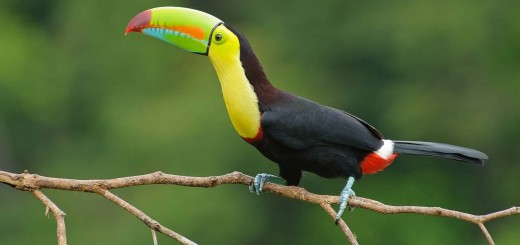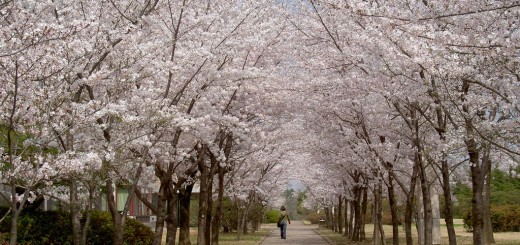10 Attractions Of Mumbai

Gateway Of India (Photo Credit: Rhaessner / CC BY-SA 3.0)
Gateway of india
The Gateway of India is a monument built during the British Raj in Mumbai City of Maharashtra state in Western India. It is located on the waterfront in the Apollo Bunder area in South Mumbai and overlooks the Arabian Sea. The structure is a basalt arch, 26 m high.
It lies at the end of Chhatrapati Shivaji Marg at the water’s edge in Mumbai Harbour. It was a crude jetty used by the fishing community which was later renovated and used as a landing place for British governors and other prominent people. In earlier times, it would have been the first structure that visitors arriving by boat in Mumbai would have seen.
The Gateway has also been referred to as the Taj Mahal of Mumbai and is the city’s top tourist attraction. The structure was erected to commemorate the landing of their Majesties King George V and Queen Mary at Apollo Bunder, when they visited India in 1911. Built in Indo-Saracenic style, the foundation stone for the Gateway of India was laid on 31 March 1911.
The final design of George Wittet was sanctioned in 1914 and the construction of the monument was completed in 1924. The Gateway was later the ceremonial entrance to India for Viceroys and the new Governors of Bombay. It served to allow entry and access to India. The monument has witnessed three terror attacks from the beginning of the 21st century; twice in 2003 and it was also the disembarkation point in 2008 when four gunmen attacked the Taj Mahal Palace & Tower.

Gateway Of India (Photo Credit: Aakash Gupte / CC BY 2.0)
Girgaon Chowpatty

Chowpatti (Photo Credit: Nikkul / CC BY-SA 2.0)
Girgaon Chaupati commonly known as just Chaupati is one of the most famous public beaches adjoining Marine Drive in the Girgaon area of Mumbai, India. The beach is famous for Ganesh Chaturthi celebrations when hundreds of people from all over Mumbai come to immerse the idols of Lord Ganapati in the Arabian Sea. It is also one of the many places in the city where the Ramlila is performed on a stage every year.
An effigy of Ravan, that is erected on the sand is burnt by the end of the 10-day performance. One can find several bhelpuri, panipuri, ragda patties and pav bhaji vendors on the beach. On the road running along the beach, the lone surviving terrorist of the 26/11 attacks, Ajmal Kasab was caught and arrested. A bronze statue of Tukaram Omble, the cop who helped nab Kasab was erected on 26/11/11.

Chowpatti Beach (Photo Credit: Toksave / CC BY-SA 3.0)
Elephanta Caves
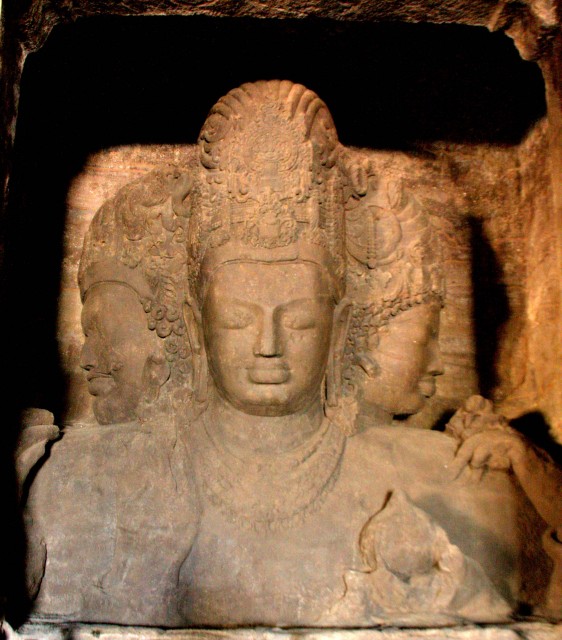
Elephanta Caves (Photo Credit: Christian Haugen / CC BY 2.0)
The Elephanta Caves are a network of sculpted caves located on Elephanta Island or Gharapuri in Mumbai Harbour, 10 km to the east of the city of Mumbai in the Indian state of Maharashtra. The island, located on an arm of the Arabian Sea, consists of two groups of caves the first is a large group of five Hindu caves, the second, a smaller group of two Buddhist caves.
The Hindu caves contain rock cut stone sculptures, representing the Shaiva Hindu sect, dedicated to the Lord Shiva. The rock cut architecture of the caves has been dated to between the 5th and 8th centuries, although the identity of the original builders is still a subject of debate. The caves are hewn from solid basalt rock. All the caves were also originally painted in the past but now only traces remain.

Elephanta Nataraja Panel (Photo Credit: Sivaraj / CC BY-SA 3.0)
The main cave was a Hindu place of worship until Portuguese rule began in 1534, after which the caves suffered severe damage. This cave was renovated in the 1970s after years of neglect and was designated a UNESCO World Heritage Site in 1987 to preserve the artwork. It is currently maintained by the Archaeological Survey of India.

Elephant Lingam Shrine (Photo Credit: Sivaraj / CC BY-SA 3.0)
Haji Ali Dargah
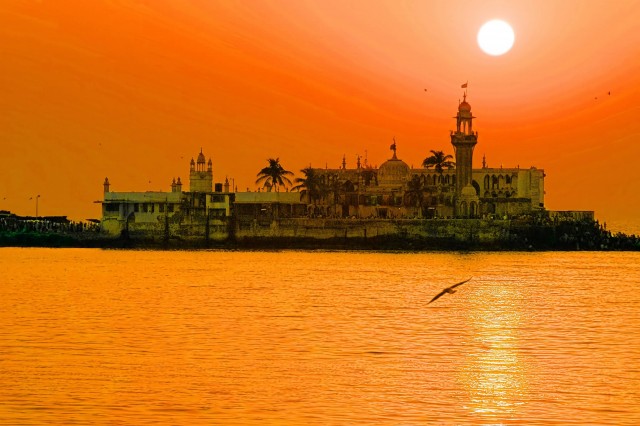
Hajiali (Photo Credit: Humayunn Peerzaada / CC BY-SA 2.0)
The Haji Ali Dargah is a mosque and dargah located on an islet off the coast of Worli in the Southern part of Mumbai. Near the heart of the city proper, the dargah is one of the most recognisable landmarks of Mumbai. An exquisite example of Indo-Islamic Architecture, associated with legends about doomed lovers, the dargah contains the tomb of Sayed Peer Haji Ali Shah Bukhari.

Haji Ali (Photo Credit: Krupasindhu Muduli / CC BY-SA 3.0)
On Thursdays and Fridays, the shrine is visited by at least 40,000 pilgrims. Irrespective of faith and religion, people visit the dargah to get the blessings of the legendary saint. Sometimes, especially on Fridays, various Sufi musicians perform a form of devotional music called Qawwali at the dargah.
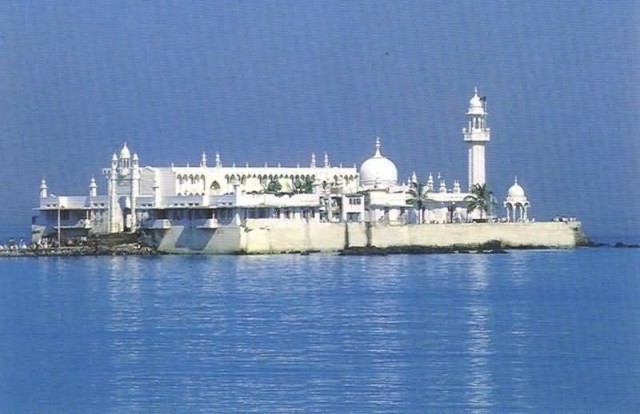
Haji Ali Dargah (Photo Credit: Original Uploader/ Public Domain)
Mahalaxmi Temple
Mahalaxmi Temple is one of the most famous temples of Mumbai situated on Bhulabhai Desai Road in Mahalaxmi area. It is dedicated to Mahalakshmi the central deity of Devi Mahatmyam. The temple was built in 1831 by Dhakji Dadaji, a Hindu merchant. It is only 1 km from Mahalakshmi railway station in Mumbai. There are two more temples viz.

Deepmala (Photo Credit: Ankur P / CC BY-SA 2.0)
Tryambakeshwar temple and Mahadev dhakleshwar temple near to the temple The temple contains images of the goddesses Mahalakshmi, Mahakali and Mahasaraswati. All three images are adorned with nose rings, gold bangles and pearl necklaces. The image of Mahalakshmi is in the center shown holding lotus flowers in tandem. The compound of this temple contains several stalls that sell flower garlands and other paraphernalia used by devotees for worship and as offering.
Kanheri Caves

Kanheri (Photo Credit: wikipedia / CC BY-SA 3.0)
The Kanheri Caves constitute a group of rock-cut monuments that are located to the north of Borivali on the western outskirts of Mumbai, India. Located within the forests of the Sanjay Gandhi National Park, the caves are 6 km from the main gate and 7 km from Borivali Station. Tourists can enter after 7:30 a.m. The Kanheri Caves demonstrate the Buddhist influence on the art and culture of India.

Kanheri Main Vihara (Photo Credit: wikipedia / CC BY-SA 3.0)
Kanheri comes from the Sanskrit Krishnagiri, which means black mountain. They were chiseled out of a massive basaltic rock outcropping. Kanheri caves offer picnickers a getaway, especially during the rainy season. The hilly terrain of the caves creates several large and small waterfalls. The road from the entry point of Sanjay Gandhi National Park to Kanheri caves is bisected by streams where families can enjoy lazy weekend gatherings.

Kanheri Cave (Photo Credit: wikipedia / CC BY-SA 3.0)
Sanjay Gandhi National Park

Sanjay Gandhi National Park (Photo Credit: Sobarwiki/ Public Domain)
Sanjay Gandhi National Park previously Borivali National Park is a large protected area in the northern part of Mumbai city in Maharashtra State in India. It encompasses an area of 104 km2 and is surrounded on three sides by India’s most populous city. It is notable as one of the major national parks existing within a metropolis limit and is one of the most visited parks in the world.

Leopard (Photo Credit: Marcus334 / CC BY-SA 3.0)
The rich flora and fauna of Sanjay Gandhi National Park attracts more than 2 million visitors every year. Tourists also enjoy visiting the 2400 years old Kanheri caves sculpted out of the rocky cliffs which lie within the park. The park is a bustling forest with an estimated 800 types of mauve. This flower is native to the park and the surrounding regions, including Karnala, the Yeoor hills, Tungareshwar and some parts of Goregaon’s Film City. The park is also home to a small population of leopards.

River In National Park (Photo Credit: wikipedia / CC BY-SA 3.0)
Jehangir Art Gallery

Jehangir Art Gallery (Photo Credit: gsurya / CC BY-SA 2.0)
The Jehangir Art Gallery is an art gallery in Mumbai. It was founded by Sir Cowasji Jehangir at the urging of K. K. Hebbar and Homi Bhabha. It was built in 1952. Managed by the Committee of Management, the entire cost of this mansion was donated by Cowasji Jehangir. This gallery is situated at Kala Ghoda, behind the Prince of Wales Museum, in South Mumbai near the Gateway of India and has four exhibition halls. The gallery was designed by G.M.Bhuta for G.M. Bhuta & Associates.

Jehangir Art Gallery (Photo Credit: Neeraj Pattath / CC BY-SA 3.0)
Nehru Centre

Nehru Centre (Photo Credit: Sanyam Bahga / CC BY-SA 3.0)
Nehru Centre is a memorial to Pt. Jawahar Lal Nehru, who symbolised the ideals of enlightened curiosity, scientific temper, secular values and a faith in the people of India. The purpose of this Centre is to promote the teachings and ideals of Nehru through educational and cultural programmes.

Nehru Science Center (Photo Credit: Ananyaalien / CC BY-SA 3.0)
The Centre organises scientific, cultural and educational activities. The centre is spread over 20,000 sq.ft. of space. It consists of a Nehru Planetarium, Discovery of India, Exhibition Hall, An Auditorium for 1000 people, experimental theatre, art galleries, Culture Wing, library and research centres.

Nehru Centre (Photo Credit: Shivsh0336 / CC BY-SA 3.0)
Castella de Aguada
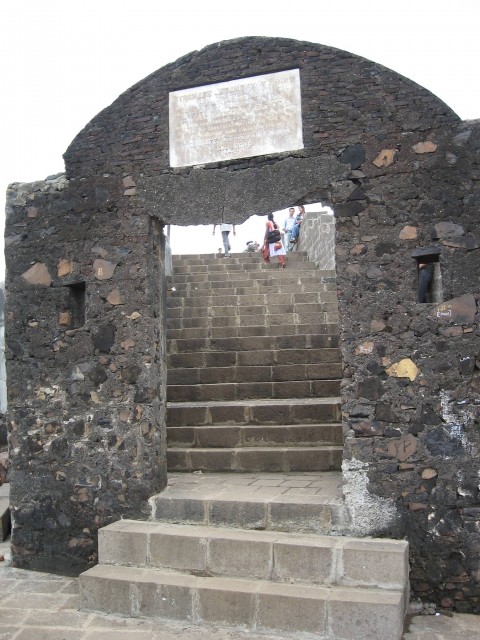
Castella De Aguada (Photo Credit: Nicholas / CC BY-SA 3.0)
Castella de Aguada also known as the Bandra Fort is a fort located in Bandra, Mumbai. “Castella” is a misspelling for Portuguese “Castelo”. Properly, it should be called Castelo da Aguada, although it seems its Portuguese builders actually called it Forte de Bandorá. It is located at Land’s End in Bandra. It was built by the Portuguese in 1640 as a watchtower overlooking Mahim Bay, the Arabian Sea and the southern island of Mahim.

Castella De Aguada (Photo Credit: Nicholas / CC BY-SA 3.0)
The strategic value of the fort was enhanced in 1661 after the Portuguese ceded the seven islands of Bombay that lay to the immediate south of Bandra to the English. The name indicates its origin as a place where fresh water was available in the form of a fountain for Portuguese ships cruising the coasts in the initial period of Portuguese presence. The fort lies over several levels, from sea level to an altitude of 24 metres. Castella de Aguada has been featured in several Hindi films, such as Dil Chahta Hai and Buddha Mil Gaya.

Castella De Aguada (Photo Credit: Nicholas / CC BY-SA 3.0)














